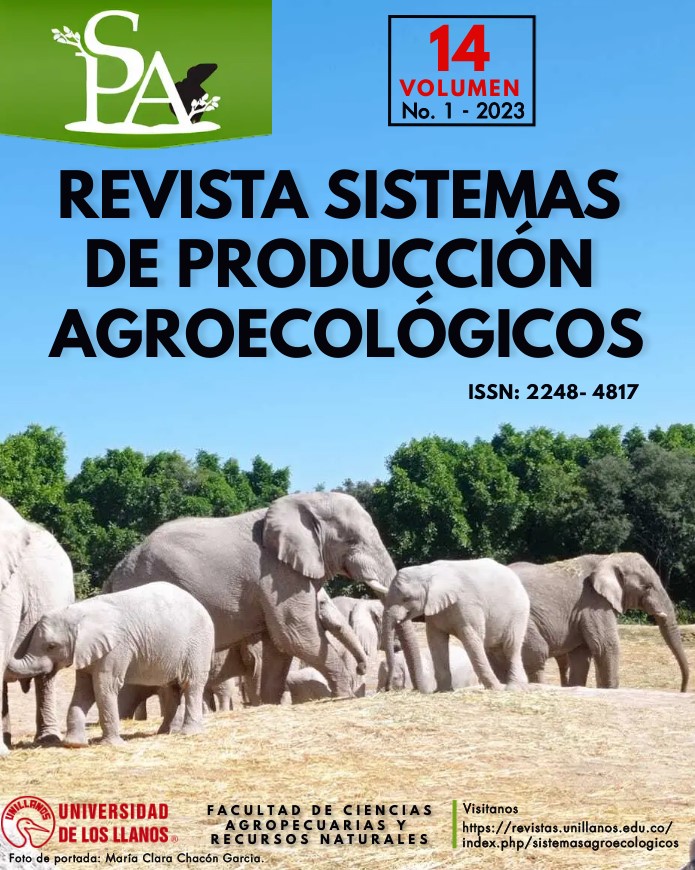Influenza aviar de alta patogenicidad y sus saltos interfaces entre aves y mamíferos: situación actual
Highly pathogenic avian influenza and its interface jumps between birds and mammals: current situation
Contenido principal del artículo
Resumen
La influenza aviar, causada por cepas altamente patógenas del virus de la influenza tipo A, ha sido objeto de preocupación global debido a su capacidad para infectar a aves de corral y vida silvestre, así como a su potencial para transmitirse a los seres humanos. En este artículo de revisión, se examinan los datos y la información proporcionada por los Centros para el Control y la Prevención de Enfermedades (CDC), Organización mundial de Sanidad Animal (OMSA), Departamento de Agricultura (USDA-APHIS) y la Biblioteca Nacional de Medicina (PubMed) de los Estados Unidos, sobre la influenza aviar. Se abordan aspectos clave de la enfermedad, incluyendo su epidemiología, mecanismos de transmisión, manifestaciones clínicas, diagnóstico, prevención y control. Además, se exploran los últimos avances en la investigación y se discuten las perspectivas futuras en el campo de la influenza aviar.
Descargas
Detalles del artículo
Palabras clave
Referencias
Abbasi J. La gripe aviar ha comenzado a propagarse entre los mamíferos: esto es lo que es importante saber. JAMA, 2023; 329(8):619–621. Doi: 101001/jama20231317.
Abutarbush S. M, Hamdallah A, Hawawsheh M, Alsawalha L, Elizz N A, Dodeen R & Mahrous H. Implementation of one health approach in Jordan: Joint risk assessment of rabies and avian influenza utilizing the tripartite operational tool. One Health, 2022; 15, 100453. Doi: 10.1016/j.onehlt.2022.100453.
Agüero M, Monne I, Sánchez A, Zecchin B, Fusaro A, Ruano MJ, Del Valle Arrojo M, Fernández-Antonio R, Souto AM, Tordable P, Cañás J, Bonfante F, Giussani E, Terregino C, Orejas JJ. Highly pathogenic avian influenza A(H5N1) virus infection in farmed minks, Spain, October 2022. Euro Surveill, 2023; 28(3):2300001. Doi: 102807/1560-7917ES20232832300001.
Bi Y, Tan S, Yang Y, Wong G, Zhao M, Zhang Q, Wang Q, Zhao X, Li L, Yuan J, Li H, Li H, Xu W, Shi W, Quan C, Zou R, Li J, Zheng H, Yang L, Liu WJ, Liu D, Wang H, Qin Y, Liu L, Jiang C, Liu W, Lu L, Gao GF, Liu Y. Clinical and Immunological Characteristics of Human Infections With H5N6 Avian Influenza Virus. Clin Infect Dis, 2019; 68(7):1100-1109. Doi: 10.1093/cid/ciy681.
Blaurock C, Blohm U, Luttermann C, Holzerland J, Scheibner D, Schäfer A, Groseth A, Mettenleiter TC & Abdelwhab E. The C-terminus of non-structural protein 1 (NS1) in H5N8 clade 2344 avian influenza virus affects virus fitness in human cells and virulence in mice. Emerging Microbes & Infections, 2021; 10:1, 1760-1776, Doi: 101080/2222175120211971568.
Bordes L, Vreman S, Heutink R, Roose M, Venema S, Pritz-Verschuren SBE, Rijks JM, Gonzales JL, Germeraad EA, Engelsma M, Beerens N. Highly Pathogenic Avian Influenza H5N1 Virus Infections in Wild Red Foxes (Vulpes vulpes) Show Neurotropism and Adaptive Virus Mutations Microbiol Spectr, 2023; 11(1):e0286722. Doi: 101128/spectrum02867-22.
Briand FX, Souchaud F, Pierre I, Beven V, Hirchaud E, Hérault F, et al. Virus de la influenza aviar altamente patógena A(H5N1) clado 2.3.4.4b en gato doméstico, Francia. Emerg Infect Dis. 2023. Doi: 10.3201/eid2908.230188.
Bui CHT, Kuok DIT, Yeung HW, Ng KC, Chu DKW, Webby RJ, Nicholls JM, Peiris JSM, Hui KPY, Chan MCW. Risk Assessment for Highly Pathogenic Avian Influenza A(H5N6/H5N8) Clade 2.3.4.4 Viruses. Emerg Infect Dis, 2021; 27(10):2619-2627. Doi: 10.3201/eid2710.210297.
Bussey KA , Bousse TL , Desmet EA , Kim B , Takimoto T. El residuo de PB2 271 juega un papel clave en la actividad de polimerasa mejorada de los virus de influenza A en células huésped de mamíferos. J Virol, 2010; 84 ( 9 ): 4395 – 406. Doi: 101128/JVI02642-09.
CDC. Centros para el Control de Enfermedades de los Estados Unidos. (2023a). Aparición y evolución de la influenza aviar H5N1. Disponible en: https://espanolcdcgov/flu/avianflu/communication-resources/bird-flu-origin-infographichtml.
CDC. Centros para el Control de Enfermedades de los Estados Unidos. (2023b). Reportan caso de virus de influenza aviar humana A(H5) en EE.UU. Disponible en: https://www.cdc.gov/media/releases/2022/s0428-avian-flu.html.
CDC. Centros para el Control de Enfermedades de los Estados Unidos. (2023c). Aspectos destacados en la historia de la influenza aviar (gripe aviar) Cronología - 2020-2023. Disponible en: https://www.cdc.gov/flu/avianflu/timeline/avian-timeline-2020s.htm.
CDC. Centros para el Control de Enfermedades de los Estados Unidos. (2023d). Actualización sobre la influenza H5N1: dos casos de influenza H5N1 en humanos en Camboya. Disponible en: https://espanolcdcgov/flu/avianflu/human-cases-cambodiahtm.
CDC. Centros para el Control de Enfermedades de los Estados Unidos (2023e). Infecciones por virus de la influenza aviar en humanos. Disponible en: https://espanol.cdc.gov/flu/avianflu/avian-in-humans.htm.
CDC. Centros para el Control de Enfermedades de los Estados Unidos (2023f). Informe técnico: Virus de la influenza aviar A(H5N1) altamente patógena- Actividades de preparación de los CDC y el gobierno de EE. UU. Disponible en: https://www.cdc.gov/flu/avianflu/spotlights/2022-2023/h5n1-technical-report.htm#preparedness.
Cheng, C., Holyoak, M., Xu, L., Li, J., Liu, W., Stenseth, N. C., & Zhang, Z. Host and geographic barriers shape the competition, coexistence, and extinction patterns of influenza A (H1N1) viruses. Ecology and Evolution, 2022; 12(3), 1–16. Doi: 10.1002/ece3.8732.
Feare, CJ. El papel de las aves silvestres en la propagación de HPAI H5N1 Enfermedades aviares, 2007; 51 (s1), 440-447. Doi: 101637/7575-040106R11.
Gamarra V, Toledo P, Inga G, Gutiérrez R, García-Tello O, Valdivia-Ramírez L, Huamán-Mendoza D, Nieto-Navarrete J, Ventura S, Lambertucci S. Primera Mortalidad Masiva de Mamíferos Marinos Causada por el Virus de la Influenza Altamente Patógena (H5N1) en Sudamérica. 2023, Preimpresión. Doi: 101101/20230208527769.
Gu W, Shi J, Cui P, Yan C, Zhang Y, Wang C, Zhang Y, Xing X, Zeng X, Liu L, Tian G, Suzuki Y, Li C, Deng G, Chen H. Novel H5N6 reassortants bearing the clade 2.3.4.4b HA gene of H5N8 virus have been detected in poultry and caused multiple human infections in China. Emerg Microbes Infect, 2022; 11(1):1174-1185. Doi: 10.1080/222217512022.2063076.
Haque A, Hober D, Kasper LH. Confronting potential influenza A (H5N1) pandemic with better vaccines. Emerg Infect Dis, 2007; (10):1512-8. Doi: 10.3201/eid1310.061262.
Imai M, Herfst S, Sorrell EM, Schrauwen EJ, Linster M, De Graaf M, Fouchier RA, Kawaoka Y. Transmission of influenza A/H5N1 viruses in mammals. Virus Res. 2013 Dec 5;178(1):15-20. Doi: 10.1016/j.virusres.2013.07.017.
Kanaujia R, Bora I, Ratho RK, Thakur V, Mohi, G. K., & Thakur, P. Avian influenza revisited: concerns and constraints. VirusDisease, 2022; 33(4), 456–465. Doi: 10.1007/s13337-022-00800-z.
Le T.H, Nguyen N.T. Evolutionary dynamics of highly pathogenic avian influenza A/H5N1 HA clades and vaccine implementation in Vietnam. Clin Exp Vaccine Res, 2014; 3(2):117-27. Doi: 10.7774/cevr.2014.3.2.117.
Newman SH, Hill NJ, Spragens KA, Janies D, Voronkin IO, Prosser DJ, et al. Eco-Virological Approach for Assessing the Role of Wild Birds in the Spread of Avian Influenza H5N1 along the Central Asian Flyway PLoS ONE, 2012; 7(2): e30636. Doi: 101371/journalpone0030636.
OIV. Organización de la inspección veterinaria de Polonia. Comunicación de la IV GLW sobre la enfermedad de los gatos. 2023. Disponible en: https://www.wetgiw.gov.pl/main/komunikaty/Komunikat-IV-GLW-w-sprawie-choroby-kotow/idn:2287.
Oliver I, Roberts J, Brown CS, Byrne AM, Mellon D, Hansen R, Banyard AC, James J, Donati M, Porter R, Ellis J, Cogdale J, Lackenby A, Chand M, Dabrera G, Brown IH, Zambon M. A case of avian influenza A (H5N1) in England, January 2022. Euro Surveill, 2022; 27(5):2200061. Doi: 10.2807/1560-7917.ES.2022.27.5.2200061.
OMS. Organización mundial de Salud. Virus de la gripe aviar y otros virus de la gripe de origen zoonótico. 2018. Disponible en: https://www.who.int/es/news-room/fact-sheets/detail/influenza-(avian-and-other-zoonotic)?gclid=CjwKCAiAr4GgBhBFEiwAgwORrbtNMab8fkvv_ZNjS44EkinL4vvCyvg41fTJjj0U-eSuNEiZboSJdhoCH6IQAvD_BwE.
OMS. Organización mundial de Salud. (2023a). Influenza aviar A (H5N1) - Número acumulado de casos humanos confirmados de influenza aviar A (H5N1) notificados a la OMS, 2003-2023. Disponible en: https://www.who.int/docs/default-source/wpro---documents/emergency/surveillance/avian-influenza/ai_20230414.pdf?sfvrsn=5f006f99_113.
OMS. Organización mundial de Salud. (2023b) Gripe Aviar A (H5N1) – España. Disponible en: https://www.who.int/emergencies/disease-outbreak-news/item/2022-DON420.
OMS. Organización mundial de Salud. (2023c). Human infection caused by avian influenza A(H5) - Ecuador . Disponible en: https://www.who.int/emergencies/disease-outbreak-news/item/2023-DON434.
OMSA. Organización Mundial de Sanidad Animal OMSA Influenza Aviar-informe 1-19 Disponible en: https://wwwwoahorg/en/disease/avian-influenza/#ui-id-2.
OMSA. Organización Mundial de Sanidad Animal OMSA Influenza Aviar-informe 25-26. Disponible en: https://wwwwoahorg/en/disease/avian-influenza/#ui-id-2.
OPS. Organización panamericana de la salud. Alerta Epidemiológica Brotes de Influenza Aviar e infección humana causada por influenza A(H5) implicaciones para la salud pública en la Región de las Américas 11 de enero de 2023. Disponible en: https://www.paho.org/en/documents/epidemiological-update-outbreaks-avian-influenza-and-public-health-implications-region-0.
PAHO. Organización panamericana de Salud. 2023. Actualización Epidemiológica: Brotes de influenza aviar causados por influenza A(H5N1) en la Región de las Américas. Disponible en: https://www.paho.org/en/documents/epidemiological-update-outbreaks-avian-influenza-caused-influenza-ah5n1-region-americas.
Pohlmann A, King J, Fusaro A, Zecchin B, Banyard AC, Brown IH, Byrne AMP, Beerens N, Liang Y, Heutink R, Harders F, James J, Reid SM, Hansen RDE, Lewis NS, Hjulsager C, Larsen LE, Zohari S, Anderson K, Bröjer C, Nagy A, Savič V, van Borm S, Steensels M, Briand FX, Swieton E, Smietanka K, Grund C, Beer M, Harder T. Has Epizootic Become Enzootic? Evidence for a Fundamental Change in the Infection Dynamics of Highly Pathogenic Avian Influenza in Europe, 2021. mBio, 2022;13(4):e0060922. Doi: 10.1128/mbio.00609-22.
Ravikumar, R., Chan, J., & Prabakaran, M. Vaccines against Major Poultry Viral Diseases: Strategies to Improve the Breadth and Protective Efficacy. Viruses, 2022; 14(6). Doi: 10.3390/v14061195.
Sagong M, Lee YN, Song S, Cha RM, Lee EK, Kang YM, Cho HK, Kang HM, Lee YJ, Lee KN. Emergence of clade 2344b novel reassortant H5N1 high pathogenicity avian influenza virus in South Korea during late 2021. Transbound Emerg Dis, 2022; 69(5):e3255-e3260. Doi: 101111/tbed14551.
SEMANA. Gripe aviar se toma costas de Chile y afecta a casi 9.000 especies marinas. 2023. Disponible en: https://www.semana.com/mundo/articulo/gripe-aviar-se-toma-costas-de-chile-y-afecta-a-casi-9000-especies-marinas/202344/.
Sernanp. Servicio Nacional de Áreas Naturales Protegidas por el Estado. Sernanp reporta lobos marinos afectados por gripe aviar y continúa con plan de vigilancia y monitoreo en áreas naturales protegidas. Disponible en: https://bitly/3INYr3s.
Sonnberg S, Webby RJ, Webster RG. Natural history of highly pathogenic avian influenza H5N1. Virus Res, 2023; 178(1):63-77. Doi: 10.1016/j.virusres.2013.05.009.
Spackman, E., & Sitaras, I. Animal Influenza Virus - Methods and Protocols. In Springer Protocols - Methods in Molecular Biology. 2020. Disponible en: http://www.springer.com/series/7651.
UMN. Universidad de Minesota. 2023a. China reporta nuevo caso de gripe aviar H5N1. Disponible en: https://www.cidrap.umn.edu/avian-influenza-bird-flu/china-reports-new-h5n1-avian-flu-case.
UMN. Universidad de Minesota. 2023b. Las granjas avícolas de EE. UU. reducen los brotes de gripe aviar a medida que el USDA comienza las pruebas de vacunas. Disponible en: https://www.cidrap.umn.edu/avian-influenza-bird-flu/us-poultry-farms-reduce-avian-flu-outbreaks-usda-begins-vaccine-testing.
USDA. Servicio de Inspección de Sanidad Animal y Vegetal- departamento de agricultura de EE UU 2022-2023. 2023a. Detecciones de influenza aviar altamente patógena en mamíferos Disponible en: https://wwwaphisusdagov/aphis/ourfocus/animalhealth/animal-disease-information/avian/avian-influenza/hpai-2022/2022-hpai-mammals.
USDA. Servicio de Inspección de Sanidad Animal y Vegetal- departamento de agricultura de EE UU. 2023b. Hoja informativa: El USDA continúa el compromiso de sus socios para mitigar la influenza aviar altamente patógena para la temporada 2023. Disponible en: https://www.usda.gov/media/press-releases/2023/04/14/fact-sheet-usda-continues-partner-engagement-mitigate-highly.
Vreman S, Kik M, Germeraad E, Heutink R, Harders F, Spierenburg M, Engelsma M, Rijks J, Brand Jvd, Beerens N. Mutación zoonótica del virus de la influenza aviar altamente patógena H5N1 identificado en el cerebro de múltiples especies de carnívoros salvajes. Patógenos, 2023; 12(2):168. Doi:103390/pathogens12020168.
World Organisation for Animal Health. (n.d.). Avian Influenza - WOAH - World Organisation for Animal Health. Retrieved March 2, 2023, from https://www.woah.org/en/disease/avian-influenza/.
Yago M R, et al. Selective Bottlenecks Shape Evolutionary Pathways Taken during Mammalian Adaptation of a 1918-like Avian. Cell Host & Microbe, 2016; 19(February), 169–180.
Zhang Y , Zhang Q , Gao Y , He X , Kong H , Jiang Y , et al. Los factores moleculares clave en la hemaglutinina y PB2 contribuyen a la transmisión eficiente del virus de la influenza pandémica H1N1 2009. J Virol, 2012; 86 (18 ) : 9666-74. Doi: 101128/JVI00958-12.
Zhao K, Gu M, Zhong L, Duan Z, Zhang Y, Zhu Y, Zhao G, Zhao M, Chen Z, Hu S, Liu W, Liu X, Peng D, Liu X. Characterization of three H5N5 and one H5N8 highly pathogenic avian influenza viruses in China. Vet Microbiol, 2013; 163(3-4):351-7. Doi: 10.1016/j.vetmic.2012.12.025.


 PDF
PDF
 FLIP
FLIP








